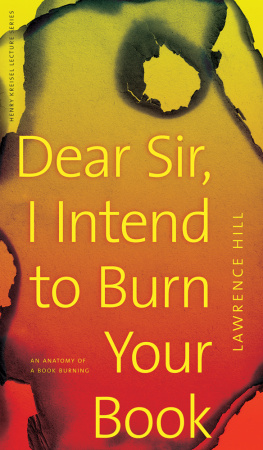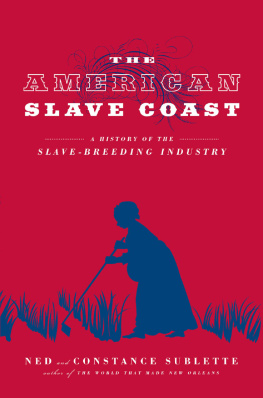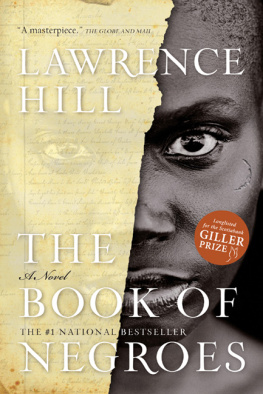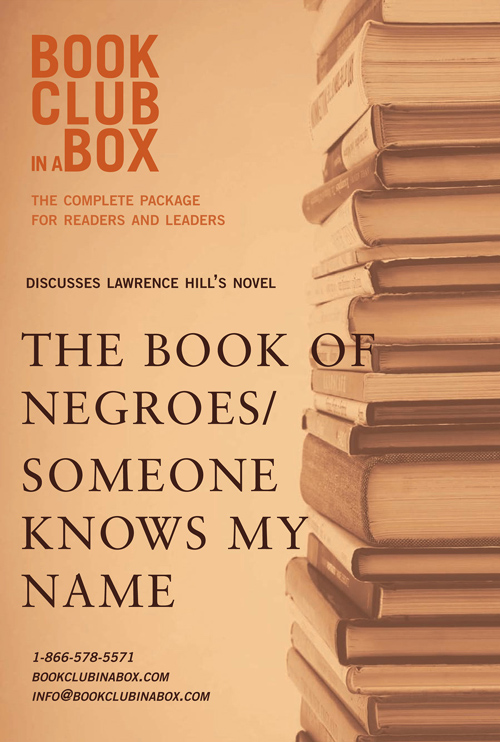BOOK
CLUB
IN A BOX
Bookclub-in-a-Box presents the
discussion companion for
Lawrence Hills novel
The Book of Negroes /
Someone Knows My Name
Novel published by HarperCollins, Toronto, Canada, 2007.
ISBN: 978-1-55468-156-3
Quotations used in this guide have been taken from the text of the paperback edition of The Book of Negroes. All information taken from other sources is acknowledged.
This discussion companion was written by Marilyn Herbert, B.Ed. She is the founder of Bookclub-in-a-Box and an international speaker with more than 30 years experience as a teacher and school librarian. Bookclub-in-a-Box is a unique guide to current fiction and classic literature intended for book club discussions, educational study seminars, and personal pleasure.
This guide was co-written by Erin Balser. For more information about the Bookclub-in-a-Box team, visit our website.
Bookclub-in-a-Box discussion companion for
The Book of Negroes /
Someone Knows My Name
(PRINT) ISBN: 978-1897082-591
(E-PUB) ISBN: 978-1897082-881
(E-PDF) ISBN: 978-1897082-898
This guide reflects the perspective of the Bookclub-in-a-Box team and is the sole property of Bookclub-in-a-Box. Guide first published in 2010.
2011 BOOKCLUB-IN-A-BOX
Unauthorized reproduction of this book or its contents for republication in whole or in part is strictly prohibited.
BOOKCLUB-IN-A-BOX
Lawrence Hills The Book of Negroes/Someone Knows My Name
BOOKCLUB-IN-A-BOX
Readers and Leaders Guide
Each Bookclub-in-a-Box guide is clearly and effectively organized to give you information and ideas for a lively discussion, as well as to present the major highlights of the novel. The format, with a Table of Contents, allows you to pick and choose the specific points you wish to talk about. It does not have to be used in any prescribed order. In fact, it is meant to support, not determine, your discussion.
You Choose What to Use
You may find that some information is repeated in more than one section and may be cross-referenced so as to provide insight on the same idea from different angles.
How to Begin
Relax and look forward to enjoying your book club.
With Bookclub-in-a-Box as your behind-the-scenes support, there is little for you to do in the way of preparation.
Some readers like to review the guide after reading the novel; some before. Either way, the guide is all you will need as a companion for your discussion. You may find that the guides interpretation, information, and background have sparked other ideas not included.
Having read the novel and armed with Bookclub-in-a-Box, you will be well prepared to lead or guide or listen to the discussion at hand.
Lastly, if you need some more hands on support, feel free to contact us.
What to Look For
Each Bookclub-in-a-Box guide is divided into easy-to-use sections, which include points on characters, themes, writing style and structure, literary or historical background, author information, and other pertinent features unique to the novel being discussed. These may vary slightly from guide to guide.
INTERPRETATION OF EACH NOVEL REFLECTS THE PERSPECTIVE OF THE BOOKCLUB-IN-A-BOX TEAM.
Do We Need to Agree?
THE ANSWER TO THIS QUESTION IS NO.
If we have sparked a discussion or a debate on certain points, then we are happy. We invite you to share your groups alternative findings and experiences. You can contact us via our website (www.bookclubinabox.com), by email (info@bookclubinabox.com), or by phone (1-866-578-5571). We would love to hear from you.
Discussion Starters
There are as many ways to begin a book club discussion as there are members in your group. If you are an experienced group, you will already have your favorite ways to begin. If you are a newly formed group or a group looking for new ideas, here are some suggestions.
- Ask for peoples impressions of the novel. (This will give you some idea about which parts of the unit to focus on.)
- Identify a favorite or major character.
- Identify a favorite or major idea.
- Begin with a powerful or pertinent quote. (Not necessarily from the novel.)
- Discuss the historical information of the novel. (Not applicable to all novels.)
- If this author is familiar to the group, discuss the range of his/her work and where this novel stands in that range.
- Use the discussion topics and questions in the Bookclub-in-a-Box guide.
If you have further suggestions for discussion starters, be sure to share them with us and we will share them with others.
Above All, Enjoy Yourselves
INTRODUCTION
INTRODUCTION
Novel Quickline
Aminata Diallo was born free in Bayo, West Africa. Her father was a prominent jeweler and her mother was a baby-catcher, a midwife. One day, on their way back from delivering a baby, 11-year-old Aminata is captured by slave traders and her mother is killed. What follows is a gruesome description of Aminata in chains, marched to the ocean, placed onto a transport ship along with thousands of other prisoners, and carried across the ocean only to be enslaved. We follow Aminata or Meena, as her slave owners call her from St. Helena Island, South Carolina, up to New York, then to Nova Scotia, back to Africa, and eventually to London.
During the course of the story, we learn about the horrors and the immorality of slavery, and we become uncomfortably familiar with the hardships of these people. We meet not only the slaves, but their owners and abusers as well. We are also shown the faces of their allies, the members of the abolitionist and Loyalist movements.
Keys to the Novel
History
- It is probably fair to say that many people do not know the whole story of how black Canadians came to Canada, how long they have been there, and how they were treated. The story of Canadas own slave history has been explored very little both in schools and in literature. A main feature of both the Canadian and American school curriculums has been to teach about the Underground Railroad.
- Lawrence Hill performed extensive research for this book, examining 57 primary documents over five years, which are listed in the back of his book. This research allows Aminatas story to be embedded in real history, while transcending it with a captivating narrative. Many people and events are based on real-life occurrences. ()
- Hills novel is a (fictionalized) historical account of people who have lost their history. As such, it falls into the tradition of slave narratives, Holocaust literature, and the literature concerning other people whose lives have been torn apart. An excellent example is What is the What, a book by writer Dave Eggers that examines the situation of Sudans lost boys. Hills novel stands alongside Eggers book and many others that explore the lives of people who are separated from their history, home, culture, and people through violence. The Book of Negroes/Someone Knows My Name is not a book of simple immigration or refugee status.
Storytelling
- The novel emphasizes the idea of storytelling in order to highlight historical facts and statistics. The power and purpose behind a fictional story is to keep peoples attention on certain events and ideas. Aminatas story is a compromise between wanting to portray an important historical time period and creating a powerful narrative. As a result, the historical accuracy strengthens the novel as the narrative introduces readers to historically important events.





